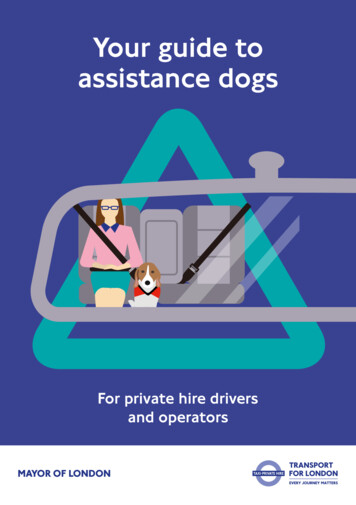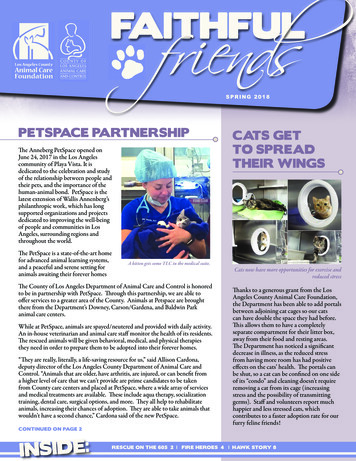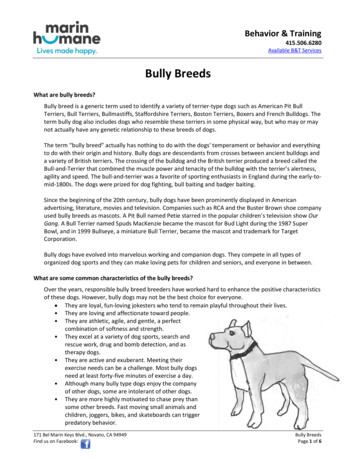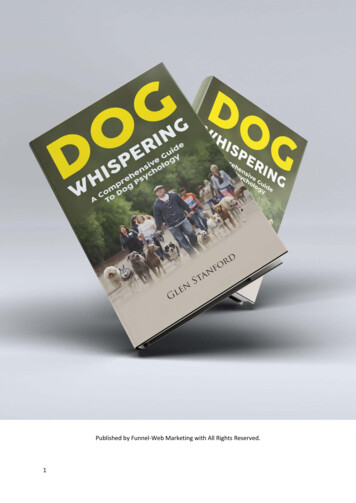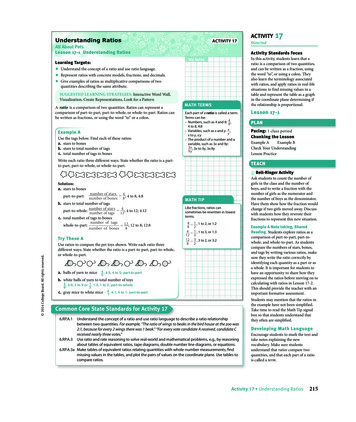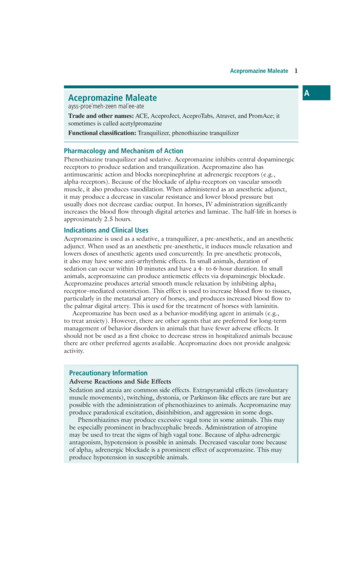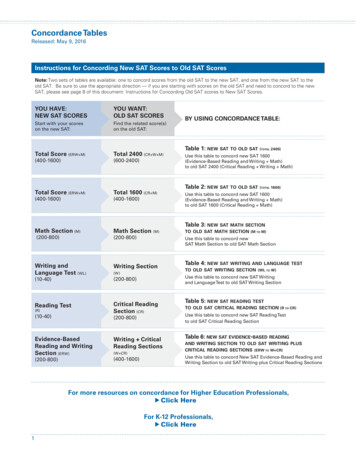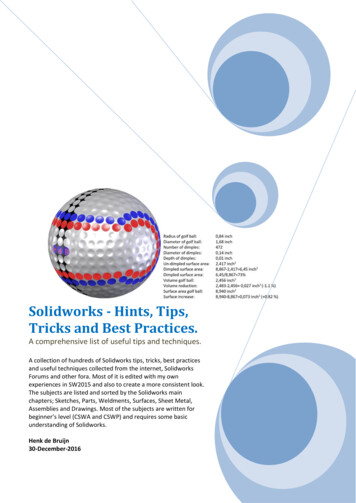
Transcription
Old Tricks, New Dogs:Ethology and InteractiveCreaturesBruce Mitchell BlumbergBachelor of Arts, Amherst College, 1977Master of Science, Sloan School of Management, MIT, 1981SUBMITTED TO THE PROGRAM IN MEDIA ARTS AND SCIENCES,SCHOOL OF ARCHITECTURE AND PLANNING IN PARTIALFULFILLMENT OF THE REQUIREMENTS FOR THE DEGREE OFDOCTOR OF PHILOSOPHY AT THE MASSACHUSETTS INSTITUTE OFTECHNOLOGYFebruary 1997 Massachusetts Institute of Technology, 1996. All Rights ReservedAuthor:.Program in Media Arts and SciencesSeptember 27,1996Certified By:.Pattie MaesAssociate ProfessorSony Corporation Career Development Professor of Media Arts and SciencesProgram in Media Arts and SciencesThesis SupervisorAccepted By:.Stephen A. BentonChair, Departmental Committee on Graduate StudentsProgram in Media Arts and Sciences1
2Old Tricks, New Dogs: Ethology and Interactive Creatures
Old Tricks, New Dogs: Ethology and Interactive CreaturesBruce M. BlumbergSUBMITTED TO THE PROGRAM IN MEDIA ARTS AND SCIENCES,SCHOOL OF ARCHITECTURE AND PLANNING ON SEPTEMBER 27, 1996IN PARTIAL FULFILLMENT OF THE REQUIREMENTS FOR THE DEGREEOF DOCTOR OF PHILOSOPHY AT THE MASSACHUSETTS INSTITUTE OFTECHNOLOGY.AbstractThis thesis seeks to address the problem of building things with behavior and character.By things we mean autonomous animated creatures or intelligent physical devices. Bybehavior we mean that they display the rich level of behavior found in animals. By character we mean that the viewer should “know” what they are “feeling” and what they arelikely to do next.We identify five key problems associated with building these kinds of creatures: Relevance (i.e. “do the right things”), Persistence (i.e. “show the right amount of persistence), Adaptation (i.e. “learn new strategies to satisfy goals”), Intentionality andMotivational State (i.e. “convey intentionality and motivational state in ways we intuitively understand”), and External Control (i.e. “allow external entity to provide realtime control at multiple levels of abstraction”). We argue that these problems can beaddressed in a computational framework for autonomous animated creatures by combining key ideas from Ethology and Classical Animation. We have developed a toolkitbased on these ideas and used it to build “Silas”, a virtual animated dog, as well as othercreatures. We believe this work makes a significant contribution toward understandinghow to build characters for interactive environments, be they virtual companions inimmersive story-telling environments, or interesting and adaptive opponents in interactive games, or as the basis for “smart avatars” in web-based worlds. While our domainis animated autonomous agents, the lessons from this work are applicable to the moregeneral problem of autonomous multi-goal, adaptive intelligent systems. Based onresults generated from our implementation of Silas and other autonomous creatures weshow how this architecture addresses our five key problems.Thesis Supervisor: Pattie Maes, Associate Professor of Media Technology, Sony Corporation Career Development Professor of Media Arts and Sciences3
4
Doctoral Dissertation CommitteeSeptember 1996Thesis Advisor:.Pattie MaesAssociate Professor, Sony Corporation Career Development Professor of MediaArts and Sciences, Massachusetts Institute of TechnlogyThesis Reader:.Alex P. PentlandAssociate Professor of Computers, Communication and Design Technology,Massachusetts Institute of TechnologyThesis Reader:.Peter M. Todd, Ph.D.Research Scientist, Max Planck Inst. for Psychological Research, Center forAdaptive Behavior and Cognition
6 of 6
Table of ContentsAcknowledgments111.0 Introduction131.1 Roadmap to Thesis162.0 Motivation 192.12.22.32.42.5Interactivity vs. Autonomy: Is There Life After Mario? 19Interactive Creatures and the Illusion of Life 21Interactive Autonomous Creatures: Practical Applications 23Interactive Autonomous Creatures: The Standpoint of ScienceSummary 26253.0 Problem Statement 293.13.23.33.43.53.6Relevance and Attention 30The Need for Coherence of Action and Goal 30Conveying Motivational State and Intentionality 31Learning and Adaptation 31Integration of external control 32Summary 324.0 Lessons from Ethology and Classical Animation 354.14.24.34.44.54.64.74.8Why Look at ethology? 35Why Look at Classical Animation? 38Ethological Perspective on Relevance and Attention 39Ethological Perspective on Coherence 41Classical Animation’s Perspective on Conveying Motivational StateEthological Perspective on Learning 44Classical Animations Perspective on External Control 47Summary 495.0 Computational Model515.1 Behaviors, Releasing Mechanisms, and Internal Variables5.1.15.1.25.25.35.45.5Releasing Mechanisms and PronomesInternal Variables 575254Behavior Groups and How Behaviors Compete 60The Motor System and Coherence of Action 65Summary of the Action-Selection Algorithm 69How Adaptation is Integrated into the Behavior 95.5.105.5.114371Relevance and Reliability 73Changes in Internal Variables Drive the Learning Process 74Short-Term Memory 76BehaviorStimulus Releasing Mechanisms 77Discovery Groups 78How New Appetitive Strategies are Integrated into the Behavior SystemHow Does the System Handle Chaining 80Detecting Classical Contingencies 81Learning the Time Course 83A Variable Learning Rate 83Summary 85795.6 Integrating External Control 855.7 Sensing and Synthetic Vision 867
5.7.15.7.25.7.35.7.45.7.55.7.6Direct Sensing 88Implementing Synthetic Vision 89Egocentric Potential Fields 90The Motion Energy Approach 92Navigation and Obstacle Avoidance using the Motion Energy method and the Importance of Boredom 94Limitations of the Motion Energy Approach 955.8 Implementation5.9 Summary 976.0 Results961016.1 Creatures In ALIVE6.1.16.1.26.1.36.1.46.1.56.1.6101Dr. J.T. Puppet 102Harold T. Hamster 103Silas T. Dog 104The “Invisible” Person and Creatures of a Lesser Kind 105Distributed ALIVE 106Summary of our experience building creatures for ALIVE 1076.2 DogMatic 1086.3 Experiments 1086.3.16.3.2Action-SelectionLearning 1106.4 Open Questions7.0 Related Work117Brooks 118Travers 118Payton 118Tyrrell 119Maes 120Summary 1207.2 Learning7.2.17.2.27.2.37.2.41131177.1 21Work in Reinforcement LearningModel based approaches 123Other Work 124Summary 1241217.3 Autonomous Animated lds 125Tu and TerzopoulosBates 127Perlin 127Dogz 128Others 128Summary 1281251268.0 Concluding Remarks 1318.1 Areas for future work8.2 Conclusion 1321319.0 References 13510.0 Appendix14110.1 Degrees of Freedom 14110.2 Motor Skills 14110.3 Major Classes Provided by Hamsterdam8144
List of FiguresFigure 1Figure 2Figure 3Figure 4Figure 5Figure 6Figure 7Figure 8Figure 9Figure 10Figure 11Figure 12Figure 13Figure 14Figure 15Figure 16Figure 17Figure 18Figure 19Figure 20Figure 21Figure 22Figure 23Figure 24Figure 25Figure 26Figure 27Figure 28Figure 29Figure 30Figure 31Figure 32Figure 33Figure 34Figure 35Figure 36Figure 37Figure 38Figure 39Figure 40Figure 41Figure 42Figure 43Figure 44Differing levels of internal and external factors can produce the same behavioralresponse. 40Mutual Inhibition provides control over persistence 43Ethological View of Operant Conditioning 46Multiple Levels of Control 48Architecture 52Each Behavior is responsible for assessing its own relevance 53Releasing Mechanisms identify significant objects or events from sensoryinput 53Example Definition of a Releasing Mechanism 54Pronomes allow sub-systems to be shared 56The Internal Variable Update Equation 57Motivational Variables 58Example Definition of a Behavior 59The Behavior Update Equation 60Behaviors are organized in groups of competing behaviors 61Example Behavior Graph 62Mutual Inhibition is used to provide robust arbitration and persistence 63Motor Skills and Degrees of Freedom insure coherent concurrent motion 67The Motor Controller supports prioritized expression of preferences 69Update Process 70Learning Equation 75FIFO Memory Model 76Discovery Groups (DG) are built and used by motivational variables to explainsignificant changes in their value 79Reliability Metric 80Strategy: Learn to re-use existing behaviors in new contexts 80How a BSRM is expanded into a Behavior Subsystem 81Reliability Contrast and the Learning Rate 84Variable Learning Rate and Re-acquisition 84Role of action-selection structures in learning process 85Synthetic Vision is used for obstacle avoidance and low-level navigation 87Silas’s vision sensor 90Egocentric potential field generated using synthetic vision 91Estimate of Approximate Motion Energy 92Control Law for Corridor Following 93“Move to Goal” Behavior Group (Motion Energy Method) 95When “doReverse” can lead to trouble 96Silas in ALIVE 102Dr. J.T. Puppet 102Silas and some of his friends 103Summary Statistics for Silas 105Inhibitory Gains Help Control Persistence 109Level Of Interest Promotes Time-Sharing 109Opportunistic Behavior 110Trace of BSRM for “HandExtended && Sitting” during training 110Demonstration of Blocking 1119
Figure 45Figure 46Figure 4710Demonstration of Chaining 112Hamster learns to anticipate shock and flee before receiving shockReinforcement Ratio’s Effect on Learning Rate 114112
AcknowledgmentsAcknowledgmentsThis thesis is dedicated to my father, Phillip I. Blumberg and my late mother, Janet M.Blumberg. My father has been a major inspiration in my life through word and deed,and it was from my mother that I inherited my love of animals.To my wife Janie, and my children Phil and Gwen I owe a tremendous debt for puttingup with a husband and dad who went back to school at age 37 “to play with hamsters atMIT”, as Gwen put it. For the record, Phil is the family expert on dogs. Many thanks toeach of you for your love and support.Pattie Maes, my advisor and friend, is one of the smartest people I know, and she hasbeen a constant source of ideas and suggestions for which I am grateful. She was theone who originally suggested that I should focus on ethology, and encouraged me todevelop Silas. She also made sure I had whatever equipment I needed. Many thanks.Sandy Pentland has also played a pivotal role in my work for which I thank him. He toohas been full of ideas and encouragement, and has been very generous in terms of histime and resources. I am constantly in awe of Sandy’s breadth of knowledge and keeninsight.Peter Todd has also had a great impact on me. Through his knowledge and probingquestions he has kept me honest and has helped me wrestle more than one tricky issueto the ground. He, together with Pattie, helped develop the approach to learningdescribed in this thesis. I must also thank his wife Anita for not giving birth on the dayof my defense.My friend and collaborator Tinsley Galyean is also owed a great deal of thanks. Tinsleyand I collaborated on a good deal of the underlying architecture of Hamsterdam, andwrote a Siggraph paper together. We even had fun doing it!I must also acknowledge my debt to Jerry Schneider of the Brain and Cognitive Sciencedepartment. It was Jerry’s course on animal behavior which opened my eyes to the fieldof ethology. Many thanks.I’d also like to thank my office mate Michael P. Johnson. Mike, together with BradRhodes have been fellow travelers on the road toward artificial life. I have learned muchfrom each of them, and value each as friends.ALIVE has been a major focus of my life over the past four years, and I must thank allof the folks who collaborated with me on ALIVE. They include: Trevor Darrell, ChrisWren, Ali Azarbayejani, Ken Russell, Sumit Basu, Flavia Sparacino, Mike Johnson,Brad Rhodes, Thad Starner, Lenny Foner, Alan Wexelblat, Johnny Yoon, Cecile Pham,Liz Manicatide and Mike Hlavac. To each of you, many thanks for late nights and greatwork.And lastly, I’d like to remember Stowie, my demented little dog. Stowie died this summer after a long and happy life and we all miss her.11
Acknowledgments12
Old Tricks, New Dogs:Ethology and InteractiveCreaturesBruce M. Blumberg, MIT Media Lab1.0 IntroductionDespite many advances in the last 10 years, most autonomous agents are best characterized as “idiot savants” which typically address a single goal such as low level navigationor information retrieval, albeit robustly, in dynamic and unpredictable environments.Moreover these agents typically have only few degrees of freedom (e.g. in the case of arobot, “turn-left”, “turn-right”, “halt”) which need to be controlled. If these agents learnfrom their experience, once again, the learning is limited to the problem of achieving asingle goal.The use of autonomous agents in computer graphics represents a case in point. SinceReynold's seminal paper in 1987, there have been a number of impressive papers on theuse of behavioral models to generate computer animation. In this approach, dubbed“behavior-based animation”, the animated creatures are endowed with the ability todecide what to do, and the ability to modify their geometry accordingly. Thus, the animation arises out of the actions of these autonomous creatures rather than from the keyframes of an animator. However, with a few exceptions, the behavioral complexity ofthe creatures created to date has been limited. Typically, the creatures pursue a singlegoal or display a single competence. For example, work has been done in locomotion[Badler93, Bruderlin89, McKenna90, Zeltzer91, Raibert91], flocking [Reynolds87],grasping [Koga94], and lifting [Badler93].Tu and Terzopoulos' fish [Tu94] represent one of the most impressive examples of abehavior-based approach to animation. In their work they have built autonomous animated fish which incorporate a physically-based motor level, synthetic vision for sensing, and a behavior system which generates realistic fish behavior. Yet even in this work,learning is not integrated into the action-selection mechanism, the fish address only one13
Introductiongoal at a time, and the action-selection architecture is hard-wired, reflecting the specifics of the underlying motor system and the repertoire of behaviors they wished to demonstrate.However, consider the problem of building a digital pet such as a dog who is intended tointeract with the user over extended periods of time. If the behavior of the dog isintended to be “lifelike” and if a rich interaction with the user is desired then there are anumber of challenges which must be overcome. These include: The behavior must make sense. That is, at every instant it should choose the actionswhich make the most sense, given its internal state (e.g. level or hunger, thirst, ordesire to play), its perception of its environment, and its repertoire of possibleactions. Moreover, the temporal pattern of its behavior should make sense as well. Ifit is working on a given goal, it should continue working on that goal until either thegoal is satisfied or something better comes along. That is, it should be able to balance persistence with opportunism and a sense of whether it is making progress, i.e.it should not get stuck in “mindless loops”. It should adapt its behavior based on its experience. Despite being born with a richrepertoire of innate behaviors a dog learns a great deal over the course of its lifetime.For example, it may learn explicit tricks from its owner. However, in addition, it alsolearns where the food dish is, what time it is typically fed, the best strategy to get itsowner to open the door and to let it out, clues that indicate a walk is forthcoming, oreven signs that its owner is in a bad mood and best avoided. Similarly, our virtualdog should be able to learn these types of lessons. It should be capable of conveying its motivational state to the viewer. Part of the funof pets such as dogs is that we attribute clear motivational states to them on the basisof their motion, posture, direction of gaze, etc. That is, we feel as if we “know” whenthey are happy or sad, aggressive or submissive. Similarly, the magic of the greatDisney animators lies in their ability to convey the apparent “emotions and feelings”of their characters through the quality of the character’s motion. Thus, if our virtualcreatures are to be appealing to the viewer, they must provide the viewer with insightinto their motivational state. Not only does this make the interaction richer, but italso helps make their behavior more explicable. It should be controllable. Typically, these creatures are going to be used within thecontext of larger system, for example, an interactive installation or story-telling environment. In these contexts, the director (human or otherwise) may want to controlthe creature’s behavior to a greater or lesser extent so as to achieve the larger goals ofthe installation or story.Addressing these challenges will bring us squarely up against what Brooks, describes asthe second research vista for Behavior-Based Artificial Intelligence in “Intelligencewithout Reason” [Brooks91]. That is:“Understanding how many behaviors can be integrated into a single robot. The primary concerns here are how independent various perceptions and behaviors can be,how much they must rely on, and interfere with each other, how a competent complete robot can be built in such a way as to accommodate all of the required individual behaviors, and to what extent apparently complex behaviors can emergefrom simple reflexes”14Old Tricks, New Dogs: Ethology and Interactive Creatures
IntroductionBrooks [Brooks91] then goes on to list several issues which will need to be addressed inorder to solve this problem. They include: Coherence: Given a multiplicity of goals and behaviors, how will coherence ofactions and goals be insured? That is, how will the system display “just the rightamount of persistence”. Relevance: How will the system take the most salient actions given its environmentand internal state or motivations. Learning: How can learning be integrated into the system so it improves with experience?To these issues we add the two additional issues mentioned above which are of particular relevance to the problem of building autonomous animated creatures: Intentionality: How can the system convey its motivational state and intentionality(i.e. what it is likely to do next) in ways that an observer will intuitively understand? External Direction: How can external control be integrated so as to allow an external entity to provide control at multiple levels of abstraction?This thesis argues that key ideas from ethology (i.e. the study of animal behavior) maybe combined with ideas from classical animation and profitably incorporated into acomputational architecture for autonomous animated creatures. Ethology is a valuablesource for ideas for three reasons. First, ethologists address relevant problems, namely“how are animals so organized that they are motivated to do what they ought to do at aparticular time” [McFarland89]. Thus, they wrestle with the issues of relevance, coherence and adaptation within the context of animal behavior. Second, they have a biastoward simple non-cognitive explanations for behavior. They stress that seemingly intelligent behavior can be the result of very simple rules or from the interaction of whatMinsky later called “many little parts, each mindless by itself” [Minsky85]. In additionthey emphasize that the behavioral and perceptual mechanisms of animals have evolvedto opportunistically take advantage of whatever regularities and constraints are affordedthem by the environment. Third, they tend to analyze behavior at the same level whichwe wish to synthesize it, i.e. in terms of black boxes such as “avoid” or “chew”. Thus,they are less concerned with how these behaviors are implemented at the neural level,than with understanding what the behaviors are, and how they interact.Classical animation is also a valuable source for ideas, because after all, classical animation is in the business of conveying motivational state and intentionality throughmovement. The great Disney animators are masters at this, not only in understandinghow creatures convey their apparent motivational state, but also in understanding theclues which we use to deduce motivational state.From ethology, we draw on the conceptual models developed by ethologists to explainhow animals organize their behavior and adapt. Specifically, we have developed anethologically inspired model of action-selection which by explicitly addressing theissues of relevance (i.e. “do the right things”) and coherence (i.e. “show the rightamount of persistence”) improves on previous work in action-selection for multi-goalautonomous agents. In addition, we have integrated an ethologically inspired approachto learning which by incorporating temporal-difference learning into this architectureOld Tricks, New Dogs: Ethology and Interactive Creatures15
Introductionallows the agent to achieve its goals either in new ways or more efficiently and robustly.From classical animation, we draw on the “tricks” used by animators to convey theintentionality and personality of their characters. Specifically, we have developed amotor-system architecture which provides the level of coherent, concurrent motion necessary to convey the creature’s motivational state (or states, as in being both hungry andfearful). In addition, we show how the entire architecture allows multiple levels of control by an external entity which may need to manipulate, in real-time, the behavior of thecreature.We have built a tool kit based on these ideas, and used it to develop a number of animated creatures including Silas, a virtual animated dog, which is one of the most sophisticated autonomous animated creatures built to date. Based on results generated fromour implementation of Silas and other autonomous creatures, we will argue that thisarchitecture solves a number of problems which have traditionally been difficult problems in the areas of action-selection and learning. While our domain is animated autonomous agents, the lessons from this work are applicable to the more general problem ofautonomous multi-goal, adaptive intelligent systems.We claim four major contributions based on the work presented in this thesis: An ethologically-inspired model of action-selection and learning. A firm (i.e. less ad-hoc) basis for the field of behavioral animation. The Hamsterdam tool kit for building and controlling autonomous animated creatures. Silas as a robust, working example.1.1 Roadmap to ThesisWe begin our discussion of ethology and Interactive Creatures in the next chapter wherewe provide our motivation for pursuing this topic. Here we argue that autonomy, atsome level, is an important addition to all interactive characters, and is especially important if one is interested in building “lifelike” characters. We discuss what we mean by“lifelike”, and then we suggest a number of practical applications for interactive creatures as well as the underlying scientific issues that are addressed through this work. Inchapter three, we summarize the five hard problems associated with building interactivecreatures. and go into some depth on each one to give the reader a sense of the issuesthat any framework or architecture for building these creatures must address. Havinglaid out the issues in chapter three, in chapter four we suggest a conceptual frameworkfor addressing these issues. Specifically, we argue that both ethology and classical animation represent fertile areas for ideas. We then suggest how each problem might beaddressed from the perspective of ethology or classical animation. In chapter five wepresent our computational model which follows rather directly from the ideas presentedin chapter four. Our presentation of the computational model is organized around theproblems we are trying to solve. In chapter six we present results which demonstrate theusefulness of our approach. These results are based on our experience building creaturesfor the ALIVE project (ALIVE is a virtual reality system in which the participant interacts with autonomous animated 3D creatures), as well as, specific experiments whichhighlight particular aspects of the architecture. We conclude chapter six with a review of16Old Tricks, New Dogs: Ethology and Interactive Creatures
Introductiona number of open issues. In chapter seven we review related work, and put our work inperspective relative to other work in the areas of action-selection, learning and interactive characters. Finally, in chapter eight we reiterate the major contributions of thiswork.Old Tricks, New Dogs: Ethology and Interactive Creatures17
Introduction18Old Tricks, New Dogs: Ethology and Interactive Creatures
Motivation2.0 MotivationDo we need autonomous interactive characters? Are there practical applications for thiswork? Are there underlying scientific issues which have application outside the narrowarea of building better and more lifelike interactive characters? In this section, we willprovide the motivation for our work by addressing these important questions.2.1 Interactivity vs. Autonomy: Is There Life After Mario?An interactive character named “Super Mario” was one of the minor hits of the Siggraph conference this year. He is the star of Nintendo’s new 3D “Super Mario” gamewhich runs on their new Ultra-64. The game involves Mario running around in what iseffectively a maze, collecting things and over-coming obstacles, all at a furious pace.The game is highly interactive as all of Mario’s actions are driven solely by the user.Superb animation makes him highly engaging as well. Indeed, it is going to be a big hitat Christmas judging by the response of the conference attendees. Upon seeing SuperMario, Tom Porter from Pixar raised a very interesting question: what would autonomybring to Super Mario? Indeed, is it necessary to have autonomous animated characters?What do we mean by autonomous anyway?According to Maes, an autonomous agent is a software system with a set of goals whichit tries to satisfy in a complex and dynamic environment. It is autonomous in the sensethat it has mechanisms for sensing and interacting with its environment, and for deciding what actions to take so as to best achieve its goals[Maes93]. In the case of an autonomous animated creature, these mechanisms correspond to a set of sensors, a motorsystem and associated geometry, and lastly a behavior system. In our terminology, anautonomous animated creature is an animated object capable of goal-directed and timevarying behavior. If it operates in real-time and interacts with the user in real time, thenit is an interactive autonomous creature.Fundamentally, autonomy is about choices, and about being self-contained. The implicitassumption is that the agent is constantly faced with non-trivial choices, and mustdecide on its own how to respond. Examples of non-trivial choices include choosingbetween two important goals, or deciding what to do on the basis of incomplete or noisydata from its sensors. It is self-contained in the sense that it does not rely on an externalentity, be it a human or a centralized decision-maker to make its decisions for it. Indeed,much of the motivation for “user interface agents” is that by taking on the job of makingchoices, they reduce the workload of the user.Now Mario is highly interactive, but is not autonomous. He has no autonomous choicesto make because they are made for him by the user. Indeed, part of the fun of the game isdriving Mario around, and in this light you would not want Mario to be any more autonomous than you want your car to be autonomous. In addition, Mario has a very constrained world with clear choice points and very trivial choices (of course the speed ofthe game makes it non-trivial to play). The interaction with the user is simple, but highbandwidth since the user is driving Mario in real time. Just as one doesn’t read the paperwhile driving down the autobahn, one doesn’t do anything else while playing “SuperMario”. In short, at first blush it would seem that Mario doesn’t need autonomy.Old Tricks, New Dogs: Ethology and Interactive Creatures19
MotivationHowever, imagine that even if he did not have any autonomy at the level of locomotion,he had the ability to respond “emotionally” to the user’s commands. Here his autonomyis limited to choosing the most appropriate expression given the user’s actions. Thus, ifthe user is making choices which weren’t progressing the game, Mario could look frustrated, but look happy if the user was, in fact, making the right choices. Similarly, ifMario was at a point in the game where he was going to face some obstacles he couldlook worried, particularly if he had been there before and the user had screwed up. Orsuppose that he could tell that the user was having problems, he could look sympathetic,or perhaps through his movements or gaze indicate the correct path or action to take.The point here is that eve
6.0 Results 101 6.1 Creatures In ALIVE 101 6.1.1 Dr. J.T. Puppet 102 6.1.2 Harold T. Hamster 103 6.1.3 Silas T. Dog 104 6.1.4 The “Invisible” Person and Creatures of a Lesser Kind 105 6.1.5 Distributed ALIVE 106 6.1.6 Summary of our experience building creatures for ALIVE 107 6.2 Do

